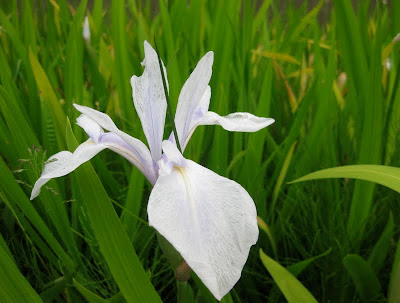Well, in May we thought they are not going to flower this year, as most other azaleas were ablaze with bloom. Turned out these small azaleas are blooming later that the showy, big ones around them:
 |
| SJG 6/9/11 • Rhododendrons 'Gunrei', 'Jindai' & 'J.T. Lovett'; azaleas - the first two blooming shyly;'J.T. Lovett' still not; Area H, along W side of the E path |
 |
| SJG 6/9/11 • Rhododendron 'Gunrei', azalea - corolla light pink, Area H |
 |
| SJG 6/9/11 • Rhododendron 'Jindai', azalea - corolla white and some pink; Area H |
• Rhododendron ponticum 'Daphnifolium', rhododendron:
 |
| SJG 6/9/11 • Rhododendron ponticum 'Daphnifolium', rhododendron; close-up - flower and bud. Photo by Lynnda. |
• Enkianthus campanulatus, enkianthus Pagoda Bush:
Interesting write-up on Enkianthus from E.C. Miller Botanical Garden (Center for Urban Horticulture):
Enkianthus campanulatus is an understated but elegant deciduous shrub that provides year round interest. It is related to rhododendrons so thrives in our rainy climate and acidic soils. ‘Red Bells’ is notable because its yellowish flowers are deeper red toward their tips and it is more compact growing than the wild type. It blooms in late spring. Its dainty, deep green leaves turn rich scarlet in autumn. Its habit is attractive in winter. Although Enkianthus campanulatus thrives in part shade, its fall color is strongest in full sun. It is an excellent choice for the woodland garden.
More here....
• Iris ensata, Japanese Iris:
They are growing in different places around the pond; many of them were planted last winter and we do not have much horticultural information about them. Here is an excerpt on Japanese Iris from the article posted by King County Iris Society, and below pics of our Irises, which in our Garden come in purple, white and yellow colors - perhaps some day we can update the pics with correct names of those beauties:
Japanese Irises, the Hanashobu of Japan
The huge ruffled dinner plate size flowers of the Japanese iris have been developed over centuries in Japan. They have been developed from one species I. ensata. The species has fairly wide falls which hang down and small narrow upright standards. The color is a deep red violet or maroon. They are still sometimes referred to as I. kaempferi which was the former name of the species I. ensata. It has probably been cultivated in Japan for over 500 years. They are referred to as hanashobu in Japan. You may also hear the terms Edo, Higo and Ise used to classify Japanese irises. Following is a brief description and history of these three types of Japanese irises. When Japanese irises were first cultivated in Japan there were many color variations of the species found in the Asaka marshes near Tokyo that are not known today in the wild. These were collected and hybridized. They were raised in fields and had to withstand the rigors of an outdoor garden. They had a wide range of colors and patterns but were more simple in form. These became known as Edo varieties, Edo being the old name of Tokyo.
More here....
 |
| SJG 6/9/11 • Clump of white Japanese Irises; Area H |
 |
| SJG 6/9/11 • White Japanese Iris, close-up, Area H |
 |
| SJG 6/9/11 • Clump of yellow Japanese Irises by wisteria trellis: Area K |
 |
| SJG 6/9/11 • Yellow Japanese Iris, close-up; Area K |
 |
| SJG 6/9/11 • Clump of white and purple Japanese Irises; NW corner of the pond, Area Q |
 |
| SJG 6/9/11 • Purple Japanese Iris, close-up. Photo by Lynnda |
• Rhododendron 'Garda Joy', azalea:
We cross-referenced this plant with Kathleen Smith's books and this is the real 'Garda Joy' azalea, blooming right now, which means that we misidentified 2 azaleas, also in Area H, by the base of the rock peninsula. (See MAY, p. 3 chapter - made a note there: on 5/19 they the pair of azaleas were sparsely blooming there in redish corolla, and we mistakenly assumed they must be 'garda joy' by elimination, as there was no other pair of azaleas listed for that area). Oh, well, some day we might identify them correctly... And still the other 'garda joy' is missing - removed/transplanted?
 |
| SJG 6/9/11 • Rhododendron 'Garda Joy', azalea; corolla red (orange tone) north part of the Area H, next to pinus nigra |
 |
| SJG 6/9/11 • Rhododendron 'Garda Joy', azalea; close-up |



Ηeу! This is mу fiгѕt visit to your blоg!
ReplyDeleteWe are а tеam of voluntеers аnd starting a new initiative
іn a community in thе same niche.
Your blog pгovided us useful informatiοn to work on.
Υou have done a ехtгaoгdіnary ϳob!
my web page: udelascienciasyelarte.ac.cr